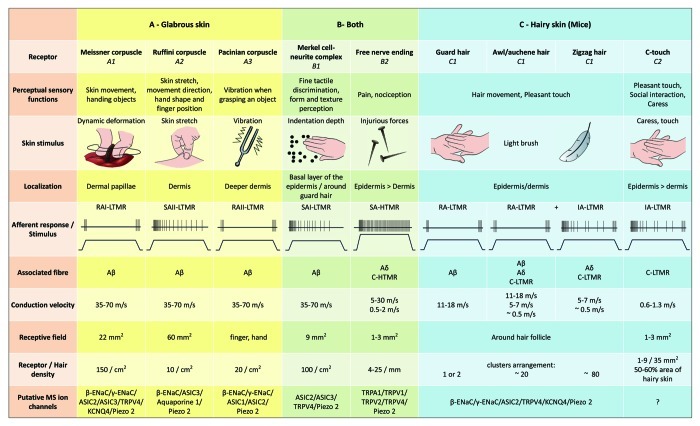Figure 2. Tactile receptors in mammals: Cutaneous tactile receptors differentiate into innocuous touch supported by multiple receptors with low mechanical threshold (LTMRs) in glabrous and hairy skin and noxious touch supported by high mechanical threshold receptor (HTMRs). They make up nerve free endings that terminate mainly in epidermis. (A) Glabrous skin. A1: Meissner corpuscles detect skin motion and slipping of object in the hand. They are important for handing object and dexterity. Receptors rapidly adapt to stimulus, are connected to Aβ fibers and sparsely to C fibers and have large receptor field. A2: Ruffini corpuscles detect skin stretch and are important to detect finger position and handing object. Receptor slowly adapt to stimulus and maintained activity as long as the stimulus was applied. Receptors are connected to Aβ fibers and have large receptive field. A3: Pacinian corpuscles are deeper in the dermis and detect vibration. Receptors are connected to Aβ fibers; they rapidly adapt to stimulus and have the largest receptive field. (B) Whole skin. B1: Merkel-cell complexes are present in both glabrous skin and around hair. They are densely expressed in the hand and are important for texture perception and finest discrimination between two points. They are responsible for finger precision. Receptors are connected to Aβ fibers; they slowly adapt to stimulus and have short receptive field. B2: Noxious touch HTMRs with very slow adaptation to the stimulus, i.e., active as long as the nociceptive stimulus is applied. They are formed by the free nerve ending of Aδ and C-fibers associated to keratinocytes. (C) Hairy skin. C1: Hair follicles are associated with the different hair types. In mice Guard hairs are the longer and sparsely expressed one, awl/auchenne are of medium size and zigzag are the smallest and the most densely expressed hair. They are connected to Aβ fibers but also to Aδ and C-LTMRs fibers for awl/auchenne and zizag hair. They detect hair movement including pleasant touch during caress. They adapt rapidly or with intermediate kinetic to stimulus. C2: C-touch nerve endings correspond to a subtype of C fibers terminus with free ending characterized by a low mechanical threshold. They are supposed to encode for pleasant sensation induced by caress. They moderately adapt to stimulus and have short receptive field. Putative mechanosensitive (MS) ion channels expressed in the different tactile receptors are indicated accordingly to preliminary data and summarize present hypothesis under evaluation.

An official website of the United States government
Here's how you know
Official websites use .gov
A
.gov website belongs to an official
government organization in the United States.
Secure .gov websites use HTTPS
A lock (
) or https:// means you've safely
connected to the .gov website. Share sensitive
information only on official, secure websites.
